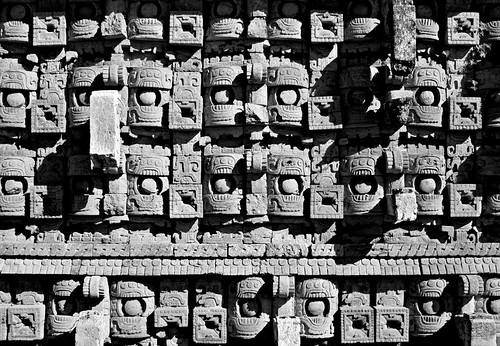The Mayan city of Kabah, with exquisite detail in the façade. The masks are representations of the god of water: Chac.
Chaac (also spelled Chac or, in Classic Mayan, Chaahk) is the name of the Maya rain deity. With his lightning axe, Chaac strikes the clouds and produces thunder and rain.
Like other Maya gods, Chaac is both one and manifold. Four Chaacs are based in the cardinal directions and wear the directional colors. Contemporary Yucatec Maya farmers distinguish many more aspects of the rain and the clouds and personify them as different, hierarchically-ordered rain deities. The Chorti Maya have preserved important folklore regarding the process of rain-making, which involved rain deities striking rain-carrying snakes with their axes.
The rain deities had their human counterparts. In the traditional Mayan (and Mesoamerican) community, one of the most important functions was that of rain-maker, which presupposed an intimate acquaintance with (and thus, initiation by) the rain deities, and a knowledge of their places and movements.
Particularly the Huastec Maya (Teenek), have a cyclical concept of water. Virile, young lightning deities dominating the skies during the rainy season are transformed into wasted, terrestrial and subterranean old men (Mamlab 'Grandfather') during the dry season; in the ocean, the old men rejuvenate themselves again. This cyclical concept may well have been shared by the Classic Period Maya.
Chaac is usually depicted with a human body showing reptilian or amphibian scales, and with a non-human head evincing fangs and a long, pendulous nose. In the Classic style, a shell serves as his ear ornament. He often carries shield and lightning-axe, the axe being personified by a closely related deity, god K, called Bolon Dzacab in Yucatec.
A large part of the most important Maya book, the Dresden Codex, is dedicated to the Chaacs, their locations, and activities. It illustrates the intimate relationship existing between the Chaacs, the Bacabs, and the aged goddess, Ixchel. The main source on the 16th-century Yucatec Maya, Bishop de Landa, combines the four Chaacs with the four Bacabs and Pauahtuns into one concept. The Bacabs were aged deities governing the subterranean sphere and its water supplies, corresponding to the Huaxtec Mamlab mentioned above.
In the Classic period, the king often impersonated the rain deity (or the associated rain serpent) while the pictogram of the rain deity can accompany the king's other names. This may be related to the king's role as a war chief, metaphorically equated with the violence of a thunderstorm. It may also, however, have given expression to his role as a supreme rain-maker.
About Chaac's role in Classic period mythological narrative, little is known. However, he is present at the resurrection of the Maya maize god from the carapace of a turtle representing the earth. Together with the skeletal Death God, he also seems to preside over an initiate's ritual transformation into a jaguar.
---- ----
Kabah (also spelled Kabaah, Kabáh, Kahbah and Kaba) is a Maya archaeological site in the south-east of the Mexican state of Yucatán.
Kabah is to the south of Uxmal, and is connected to that city by a grand 18 km long raised pedestrian causeway 5 meters wide with monumental arches at each end. Kabah is the second largest ruin of the Puuc region after Uxmal.
The name "Kabah" or "Kabaah" is usually taken to be archaic Maya language for "strong hand". This is a pre-Columbian name for the site, mentioned in Maya chronicles. An alternative name is Kabahaucan or "royal snake in the hand".
The area was inhabited by the mid 3rd century BC. Most of the architecture now visible was built between the 7th century and the 11th century. A sculpted date on a doorjamb of one of the buildings gives the date 879, probably around the city's height. Another inscribed date is one of the latest carved in the Maya Classic style, in 987. Kabaah was abandoned or at least no new ceremonial architecture built for several centuries before the Spanish conquest of Yucatán.
The most famous structure at Kabah is the "Palace of the Masks", the façade decorated with hundreds of stone masks of the long-nosed rain god Chaac; it is also known as the Codz Poop, meaning "Rolled Matting", from the pattern of the stone mosaics. This massive repetition of a single set of elements is unusual in Maya art, and here is used to unique effect.
Masks of the rain god abound on other structures throughout the site. Copal incense has been discovered in some of the stone noses of the raingods. The emphasis placed on Chaac, the "Protector of the Harvest", both here and at other neighboring Puuc sites, stemmed from the scarcity of water in the region. There are no cenotes in this dryer, northern part of the Yucatan, so the Maya here had to depend solely on rain.
Portion of "Temple of the Masks" facade as drawn by Frederick Catherwood.
The site also has a number of other palaces, low stone buildings, and step-pyramid temples. While most is in the Puuc Maya style, some show Chenes elements. The site had a number of sculpted panels, lintels, and doorjambs, most of which have been removed to museums elsewhere. The sculptures mostly depict the site's rulers and scenes of warfare.
The first detailed account of the ruin was published by John Lloyd Stephens and Frederick Catherwood in 1843.

http://en.wikipedia.org/wiki/Kabah_(Maya_site)
















No hay comentarios:
Publicar un comentario